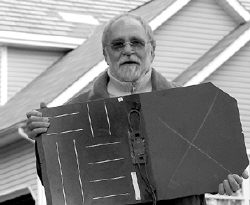
BY TARA PETERSEN (PHOTOS BY MIGUEL JUAREZ)
MILLSTONE, NJ — Imagine being able to see your meter running backward because you are generating your own power.

Jerry Sorgento believes the time has come for everyone to give solar energy a try.
The technology Sorgento uses allows for the sun to generate power during the daytime, when the meter will often run backward, and for the storage of that power so that it can be used during other times.
Though his company, New Age Solar, does sell solar panels, Sorgento is most proud of a newer generation product made by Sacramento-based Atlantis Energy Systems called Sunslates, which resemble ordinary slate roofing.
 Solar energy roofing shines in Millstone
Solar energy roofing shines in MillstoneBusinessman vows to save the planet through saving consumers money
Sorgento’s home in Millstone is the first in the state to use Sunslates.
“Nobody knows about Sunslates,” Sorgento said. “A lot of homeowners will not put solar panels on their roof because of aesthetics. Sunslates are for people who are more discerning about the look of their roof.”
Sorgento spent several years in the aerospace industry before leaving his job at Boeing in Seattle to take over his ill father’s horse farm in Manalapan. He worked on the farm for 12 years, he said, and is still a licensed Standardbred horse trainer.
When he tried to reenter his old industry in New Jersey, Sorgento discovered that “the aerospace industry left the area.”
In his mid 60s, he also felt that he was too old to be hired.
“When I sent in résumés saying I’d worked on the lunar landing program, they knew how old I was,” Sorgento said.
Sorgento started his company after taking a course about two years ago in solar energy.
“I got into it because I wanted to save the planet,” he said.
Sorgento believes that renewable energy sources are the wave of the future, and that relying on solar energy has a profoundly positive impact on the world.
“It’s cutting back on pollution, cutting back on our dependence on foreign oil, and cutting back on the oil barons taking so much money out of our economy,” he said.
According to the Department of Environmental Protection (DEP) Web site, about 82 percent of greenhouse gas emissions are from the burning fossil fuels that generate electricity and power our cars. The United States tops the charts at 6.6 tons of emissions per person per year.
The Web site further states that each person can affect about 32 percent of those pollutants “by the choices you make in three areas of your life.” The three areas are the waste that we produce, our personal transportation and “the electricity we use in our homes.”
The pollutants associated with burning fossil fuels, according to the site, have been shown to adversely affect our health, alter our ecosystems and change the climate.
We have known this for years, Sorgento said, but most people have not gone to solar or other alternative sources.
“I found that the public generally doesn’t seem to care about saving the planet, but what they were really interested in is saving money,” Sorgento said. “So in order for me to save the planet, I had to find a way to save them money.”
It’s an investment, he added, that is more affordable than ever thanks to state initiatives as part of the Clean Energy Program.
“What’s important to me is what this state is doing for the environment and [what it’s doing] to make [solar energy] affordable to the public,” Sorgento said. “New Jersey has the largest rebate program in the country.”
The state offers a flat rate rebate per DC watts of the system, which can save the consumer up to 70 percent, he said.
The buyer also qualifies for “green tags” that can be sold as a commodity to the utility companies.
Some companies that sell solar panels keep the green tags themselves, which is shortchanging the buyer, according to Sorgento.
“People need to understand the value of those green tags,” he stated. “You’re not just getting rid of your electric bill — you’re getting paid to do it. This is part of the payoff.”
The efficiency of the system depends partly on the pitch of the roof, and on how much of it is directly exposed to the sun.
Sorgento said that though in the thousands of dollars, the initial investment can be recouped in as little as five years, depending on other available incentives.
Having a home or business with little or no electric bill also adds value to the property.
Sorgento said businesses have the added advantage of getting an additional 10-percent, federal-tax rebate, and an accelerated depreciation on the product that will, in effect, give them all their money back within about five years.
This was enough to sell Tim Hundertpfund, the manager of Gaitway Farms in Manalapan, on the idea.
A few weeks ago, Sorgento installed solar panels on two of Hundertpfund’s barns, and there are plans in the works to do so for the remaining ones.
Hundertpfund said that he was skeptical at first because he knew little about solar power, but that he has known Sorgento through the horse business and trusted him enough to try it.
“I see a drastic change already,” Hundertpfund said. “During our peak hours, the meter would normally be running wild, but since it’s been installed, it slowed it right down to a crawl. And quite often, I go to it and it’s running backward.
“It looks as though it is producing as much or more than we’d anticipated,” he added.
Lance Miller, chief of staff for the New Jersey Board of Public Utilities (BPU), said that the state’s initiatives have produced great results in the areas of renewable energy.
“We’ve had a number of projects, and more and more are being constructed every day,” Miller said. “A lot of schools are looking at putting solar power on existing or new buildings.”
While the state is making strides, Sorgento is among those who fear the federal government is going in the wrong direction.
“Whether you are a Republican or a Democrat, you have to take notice that this state is a front runner,” he said. “We’re doing what the federal government should be doing.”
Miller agreed.
“We are pursuing energy efficiency standards for a variety of appliances,” Miller said, referring to the BPU. “The federal government has not developed these standards on a national level, so the states are stepping in to do that.
“The federal government has talked about weakening standards, and, for example, has lowered the energy efficiency requirement for air conditioners,” Miller continued. “It’s going in the wrong direction,”
Miller stressed the far-reaching effects of having regulations that make sense.
“Establishing the right energy policy can create jobs [and] provide for a thriving economy, and [it] also allows for a foreign policy that is liberated from energy dependence and provides increased security and a cleaner environment,” he said.
Sorgento said he hopes the state will continue its commitment by requiring a certain percentage of homes and businesses to use renewable energy sources. California has such a law, according to Sorgento.
“I’d like to see that here,” Sorgento said.
www.newagesolar.com.
No comments:
Post a Comment